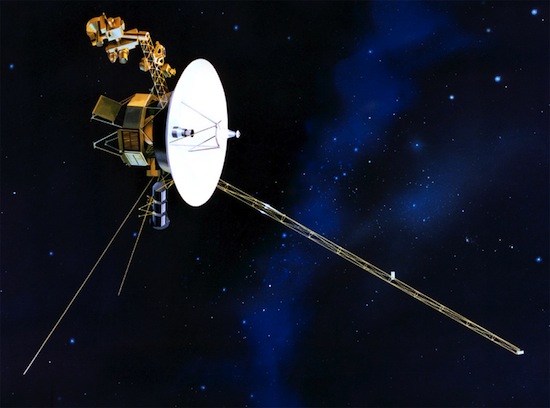Voyager Probes Not Out of the Solar System Just Yet
New data show that nearly 35 years after their launches, NASA’s Voyager probes are now at the outermost reaches of the solar system
/https://tf-cmsv2-smithsonianmag-media.s3.amazonaws.com/filer/voyager_space_header.jpg)
In 1977, the twin Voyager probes were launched by NASA with a radical mission in mind: after studying Jupiter and Saturn, scientists and engineers hoped the probes would become the first-ever human-made objects to exit the solar system.
Nearly 35 years later, data coming back from one of the probes indicates that they’re close but haven’t made it out of the solar system just yet.
According to a study published this month in Geophysical Research Letters, Voyager One is now approximately 111 astronomical units from the sun—meaning that it is 111 times farther from the sun than is the Earth. However, even drifting at this great distance, the probes continue to transmit back fascinating information about this previously uncharted area of the solar system, known as the heliosheath, where the outgoing particles of solar wind emanating from the sun are slowed by the pressure of interstellar gas.
Most recently, Voyager One detected increases in the intensity of low-energy cosmic ray electrons. As a result, scientists have concluded that the probe is has not yet passed the heliopause—generally considered the outer boundary of the solar system, where the solar wind is stopped by the interstellar medium—because outside the solar system, this electron intensity is assumed to be constant. These unexpected spikes in electron intensity may be evidence of different regions in the outer heliosheath, helping us better understand the heliospheric “bubble” where the solar system butts up against interstellar space.
In the years since their launches, the Voyagers have made a number of stunning discoveries. They’ve photographed the active volcanoes on Jupiter’s moon Io, helped us better understand the intricacies of Saturn’s rings and were the only spacecraft to visit Neptune and Uranus. Scientists back on Earth hope that the probes will gather as much information as possible before their plutonium power sources fail and they stop transmitting data forever, projected to occur sometime between 2020 and 2025.
Even after that, though, the Voyagers might have an even more significant role to play: They may serve humanity’s time capsules for future alien civilizations. Each probe carries a ”Golden Record,” Carl Sagan’s brainchild, which was designed to communicate the essence of human civilization to any forms of life they may encounter. The records contain everything from photographs of the structure of DNA to the sound of human brainwaves to greetings in 55 different languages to popular music from a wide range of different cultures, including Chuck Berry’s “Johnny B. Goode.”
In this month’s issue of Smithsonian, Timothy Ferris, who helped design the records, reflects upon the remarkable journey they have already undertaken and the amazing possibilities of what they may encounter in years to come. Ferris writes:
The Voyagers will wander forever among the stars, mute as ghost ships but with stories to tell. Each carries a time capsule, the “Golden Record,” containing information about where, when and by what sort of species they were dispatched. Whether they will ever be found, or by whom, is utterly unknown. In that sense, the probes’ exploratory mission is just beginning.
/https://tf-cmsv2-smithsonianmag-media.s3.amazonaws.com/accounts/headshot/joseph-stromberg-240.jpg)

/https://tf-cmsv2-smithsonianmag-media.s3.amazonaws.com/accounts/headshot/joseph-stromberg-240.jpg)